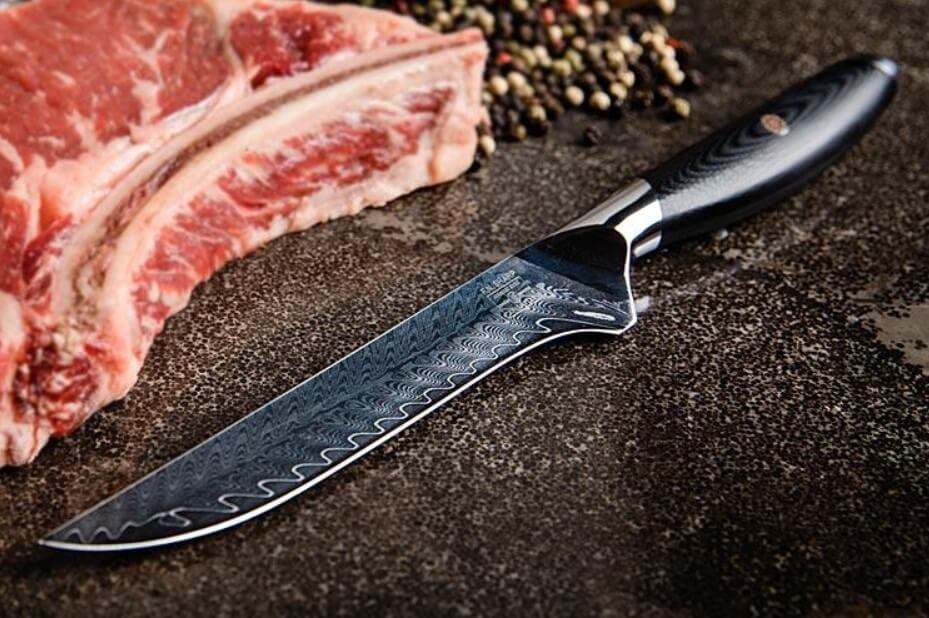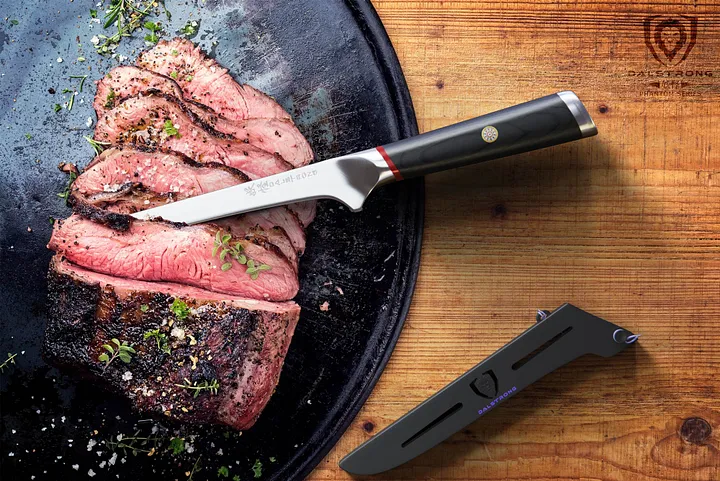Last updated on January 20th, 2024 at 04:00 am
In the kitchen, the correct equipment provide precision, productivity, and safety. Chefs and household cooks use the boning knife. Why is a boning knife essential for every cook? This guide will explain the boning knife’s purpose, benefits, and uses.
This article will teach you how to use this multipurpose kitchen tool, whether you’re a professional chef or a curious home cook.
What is a Boning Knife?
Boning knives are narrow, sharp, and flexible. It precisely separates meat from bones. Boning knives have 5–7-inch stainless steel blades that are durable and corrosion-resistant. The blade’s suppleness lets users easily navigate joints, bones, and cartilage.
What is a Boning Knife Used For?

Boning knives are used to delicately remove meat, poultry, and fish bones. Chefs can debone meat neatly with its short, sharp blade. Boning knives have many kitchen purposes besides deboning:
Removing Fat: Boning knives are great for removing fat from meat cuts due to their sharpness and manoeuvrability. A boning knife can help you get a lean steak or roast.
Filleting Fish: Boning knives are ideal for filleting fish due to their narrow, flexible blades. It glides over bones, separating flesh from skeleton. For fish preparation, a boning knife is essential for chefs and anglers alike.
Deboning Poultry: Removing poultry bones requires precision. Sharp and flexible boning knives allow the operator to manoeuvre around joints, bones, and tendons to retain the most flesh. Professional deboning requires a boning knife.
Precision Cuts (continued): From carving fruits and vegetables to trimming delicate herbs, a boning knife’s sharp, thin blade allows for precise cutting. A boning knife lets you show off your dexterity when garnishing or slicing ingredients.
Skin Removal: A boning knife helps remove meat and poultry skin. Its keen edge cuts cleanly, separating skin from flesh without waste. Boning knives help you make crispy-skinned chicken or flawlessly grilled seafood.
Splitting Joints: A boning knife can split joints, such as a whole chicken or beef roast, into smaller, more manageable pieces. Carefully manoeuvring the blade through the joints creates evenly portioned pieces for cooking or serving.
Deveining Shrimp: Shrimp are a popular seafood, however their veins can distract from a dish’s look and texture. A boning knife’s tiny, pointed tip can rapidly and efficiently remove prawn veins without damaging the delicate flesh.
Other Culinary Tasks: Boning knives can be used for other culinary operations. Its precision and manoeuvrability make it excellent for cutting fat off meat, portioning delicate pieces like lamb chops, and making beautiful cuts for plating.
How to Choose the Right Boning Knife?

To choose the proper boning knife for your cooking, examine a few critical considerations. Consider these:
Blade Type: Boning knives have stiff, semi-flexible, and flexible blades. Flexible blades are better for precise cuts than stiff ones for heavier jobs like splitting bones. Choose a blade based on your tasks.
Blade Length: Boning knives have 5–7-inch blades. Deboning smaller portions of meat or poultry requires a shorter blade for better control. However, a longer blade is ideal for filleting fish and larger chunks. Choose a blade length that matches your main elements.
Handle Comfort: A boning knife should have a comfortable, ergonomic handle for a solid grip and less hand fatigue. Choose a comfortable wood, plastic, or composite handle.
Quality and Durability: Choose a boning knife made of high-quality stainless steel or other robust materials. Well-made knives are durable, corrosion-resistant, and sharp.
Budget: Determine a suitable budget. Professional boning knives are expensive, but budget-friendly versions are available for home cooks. Choose a knife that meets your needs at a reasonable price.
Techniques for Using a Boning Knife

required to master certain skills. Boning knife techniques:
Pinch Grip: Firmly grasp the boning knife with the pinch grip. Thumb and index finger on opposing sides of the blade base, three fingers around the handle. This grip lets you cut accurately.
Deboning Poultry: Start by cutting along the breastbone. To separate the meat from the bones, slowly slide the blade along the ribs. Cut through the connecting tissues surrounding the joints to remove the bones, leaving beautifully deboned flesh.
Filleting Fish: Use a boning knife to cut behind the gills and along the backbone. The blade delicately separates flesh from bones along the backbone. Follow the fish’s curve with fluid, sweeping motions. Turn the fish and repeat. Practise makes filleting fish easy, leaving boneless fillets.
Trimming Fat: Use a boning knife to progressively remove fat from meat while maintaining as much lean meat as possible. Angle the blade slightly and make shallow cuts. Avoid excessive pressure or meat removal to avoid uneven cuts.
precise Cuts: Hold the boning knife gently and rock it for precise cuts like cutting fruits or trimming herbs. Use regulated pressure to cut ingredients smoothly.
Tips for Caring and Maintaining Your Boning Knife
Maintaining your boning knife is crucial to its longevity and performance. Remember these tips:
Hand Washing: After usage, hand wash your boning knife with warm, soapy water. Soaking the knife can harm the handle and cause corrosion.
Drying: To avoid rusting, dry the knife with a clean towel or cloth. Before storing, dry the blade and handle well.
Storage: Keep your boning knife in a knife block, sheath, or magnetic strip to avoid damage and mishaps. Avoid putting the knife in a drawer where it could get nicked or dulled.
Honing and Sharpening: Use an honing steel to realign and sharpen your boning knife regularly. Knives may need sharpening depending on use. To sharpen the knife, consult the manufacturer or a professional.
Avoid Excessive Force: Boning knives are designed for precision and flexibility, not heavy-duty jobs like cutting bones or frozen meals. Avoid overusing the knife or damaging the blade or handle.
Questions (FAQs)
Boning knives for fish filleting?
Boning knives are great for filleting fish. Its small, flexible blade slices along fish bones to easily separate the fillet from the backbone.
Boning knives are perfect for boneless fillets due to their sharpness and manoeuvrability.
Can a boning knife debone poultry?
Absolutely! Boning knives debone poultry. Its sharp and flexible blade lets you manoeuvre around joints, bones, and tendons for optimum meat retention. Boning knives are essential for deboning chickens, turkeys, and other birds.
Which boning knives are available?
Boning knives have diverse uses and preferences. Boning knives are stiff, semi-flexible, or flexible. For complex cuts, flexible boning knives are better than stiff ones.
Semi-flexible boning knives balance both. Choose a blade based on your tasks.
Boning knives for trimming beef fat?
Boning knives are ideal for reducing meat fat. Its sharp blade allows accurate cuts to reduce fat without taking too much meat. A boning knife helps you achieve leanness while cooking steaks or roasts.
How should I hold a boning knife for control?
Boning knives are often controlled using the pinch grip. Hold the knife with your thumb and index finger on opposite sides of the blade base and your other three fingers around the handle. This grip gives accurate cutting stability, control, and manoeuvrability.
Boning knives—dishwasher safe?
Boning knives should be hand washed instead of dishwashered. Dishwashers can harm knives’ blades, handles, and integrity.
The dishwasher’s heat and moisture can also cause rust. Handwashing your boning knife is best for its durability.
Conclusion
In conclusion, any chef needs a boning knife. Deboning meat, filleting fish, cutting fat, and making accurate cuts are easy with its adaptability, precision, and flexibility.
You can improve your cooking by learning about boning knives, choosing the proper one, and mastering basic techniques.
Always clean and store your boning knife appropriately. With careful maintenance, your boning knife will help you make tasty and elegant dishes for years to come.
